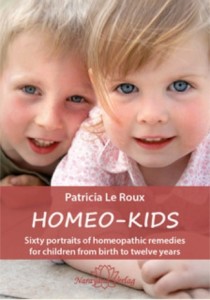This book review was first published at Hpathy.com in the November 2015 issue.
Author: Patricia Le Roux
Reviewed by: Dr. Firuzi Mehta
224 pages, hardbound.
First English edition 2015
Publishers: Narayana Verlag, Germany
ISBN: 978-3-95582-008-4
Price: USD 44.00
Patricia Le Roux (1953 – 2011) was a French pediatric consultant and homeopath, trained in homeopathy at the Faculty of Medicine of Marseilles in France where she also taught the subject. She died after a tragic accident in October 2011 and the world has lost a very good practitioner.
I had read several of her articles in the magazine Spectrum and was always impressed with the clarity of her thought and understanding of the remedies and cases she presented. When the Hpathy editor Alan Schmukler offered me a chance to review this book, I immediately agreed.
Children form a considerable percentage of any homeopathic practice since even lay people understand that homeopathy is a safe system of medicine and free of the toxic side-effects of the chemical drugs used in conventional medicine. Children, with their systems relatively unspoiled, show positive results to the correct homeopathic remedy very rapidly. We have all seen children who come to our practice, with chronic ailments, some more severe than others, which cause not just suffering to the little child, but anxiety and stress to their families as well. Conventional medicine truly has nothing much to offer in chronic conditions. With strong chemical drugs, the chronic ailment is at best suppressed and some other chronic ailment manifests very quickly. Meanwhile, the child and his family run from one specialist to another. They often come to us, disheartened with conventional medicine, and with hope in their eyes that maybe, just maybe, this ‘other’ form of medicine can help their precious little one.
With our homeopathic knowledge, we have the ability to positively modify the long-term health prospects of these little children, going so far as to diminish disease tendencies that run in the family gene pool. This is a big responsibility and also a privilege. We need to make utmost use of all resources at hand, to do the best work we can.
This book, Homeo-Kids, by Patricia Le Roux is a good addition to our libraries. The book starts with a brief summary of the basic principles of homeopathy which are then followed by her description of the remedies. Of the sixty remedies she has described here, many are polychrests commonly seen in our practice but there are also some less well-known remedies for children like Beryllium, Helium, Falco peregrinus and Chocolate. To make our work easier, she has grouped them into four main types: chilly, hot, slow and restless.
In describing each remedy, she gives a few lines of introduction about what the remedy is useful for. This is followed by describing the source of the remedy. A box of key words (main features) follows. The detailed description of each remedy is divided into two main parts: The Baby and The Child and each of these is described with the following sub-headings:
At home
At the clinic
Main clinical indications
This is followed by a brief conclusion about the remedy.
Patricia Le Roux has covered all the main features, keynotes and distinguishing characteristics of each remedy. Development issues faced by different remedies are discussed along with the pathophysiology seen in them. Key phrases are highlighted in bold, allowing a quick review for differentiation in the clinic when necessary. Physical issues and the emotional, mental and psychological aspect of each remedy are dealt with, giving a clear understanding of each remedy type. With this book, not only has Patricia Le Roux demonstrated her clear knowledge of classical methods, but she has also demonstrated her understanding of the relatively new approaches of Jan Scholten and Rajan Sankaran. With her immense clinical experience, she has been able to offer valuable tips for recognising remedies even in very small children who may not display typical signs or symptoms. There is a Remedy Index and an Alphabetical Repertory for ailments towards the end of the book.
With this book, we should be better prepared to recognise the remedies when we see them in practice. The reaction of the organism to the right remedy is phenomenal and hopefully, putting this knowledge to good use, we should be able to get far better results, truly easing the suffering of our little patients and creating better all-round health for our future generations.
You will remain with us in spirit, dear Patricia. Thank you for this wonderful book.